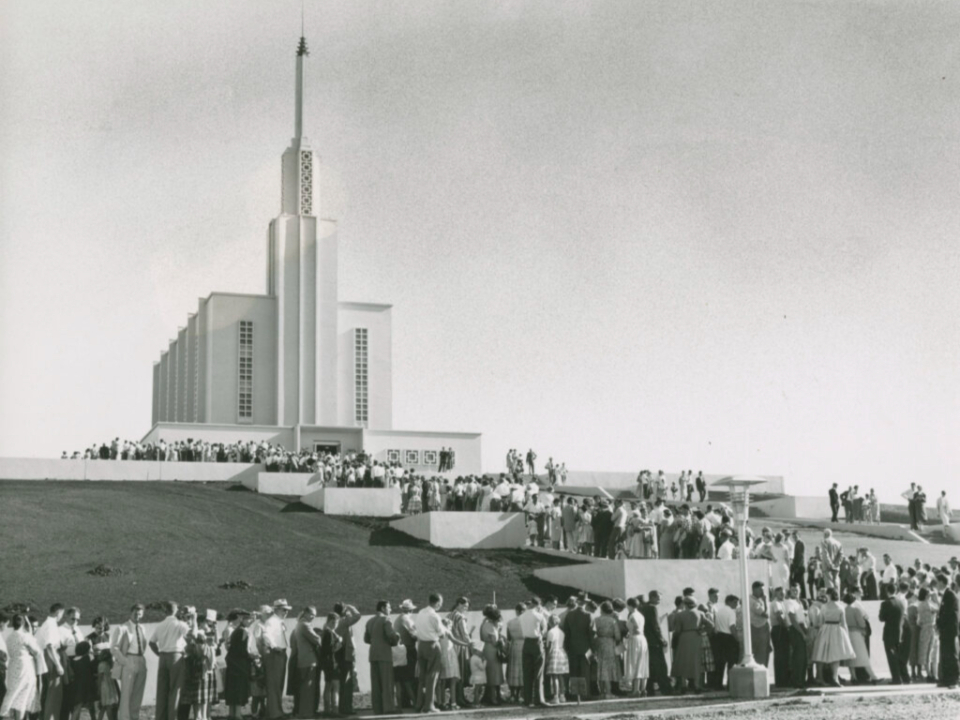
Hamilton-New-Zealand
Photo of the open house for the Hamilton New Zealand Temple, which was dedicated in 1958. Photo courtesy of Church History Library, courtesy of Church News.This story appears here courtesy of TheChurchNews.com. It is not for use by other media.
By Rachel Sterzer Gibson, Church News
In 1951, Waitohi Wineera Elkington’s husband, John Elkington, was called to help build the kingdom of God in New Zealand — literally — by helping to construct the Church College of New Zealand and later the Hamilton New Zealand Temple as a labor missionary for the Church.
Young Waitohi Elkington — affectionately known today as “Aunty Wai” — left her new, fully furnished home in Wellington, New Zealand, located in the lot next to her parents, and traveled with her husband and 3-year-old son to live in a bach, or hut, on the construction site near Hamilton.
In an interview with the Church News, Aunty Wai, who is now 92, described the bach as one room, unlined and unfurnished, with no electricity or plumbing. Windows were covered with chicken wire and shutters that could be closed. Winter rains often caused deep mud and flooding before the crews could install drains in the marshy area.
“There was nothing comfortable about the place,” Waitohi Elkington recalled. And yet, she also described that time as blessed and happy. Those who were serving shared a unified purpose. “Someday, we were going to get a school. We were going to get a temple.”
Waitohi Elkington and her husband were among the first five couples to be called as labor missionaries on what Latter-day Saints at the time referred to as “The Project.” In the end, close to 1,000 individuals donated their time and efforts. In 1958, President David O. McKay dedicated both the college and the temple.
Stories of faith and sacrifice like the Elkingtons’ are the impetus behind a new exhibition at the Matthew Cowley Church History Center and Museum located in Temple View, the Latter-day Saint community nestled among the verdant hills below the temple site. The exhibit, titled “Sacrifice and Consecration: The Lord Builds a People for the Temple,” highlights the call to serve on the project, the daily life of those in the construction camp, and the continued commitment of Latter-day Saints to sacrifice to attend the temple.
The exhibition includes photos, artifacts and stories in addition to several video recordings of labor missionaries offering firsthand accounts of their experiences.
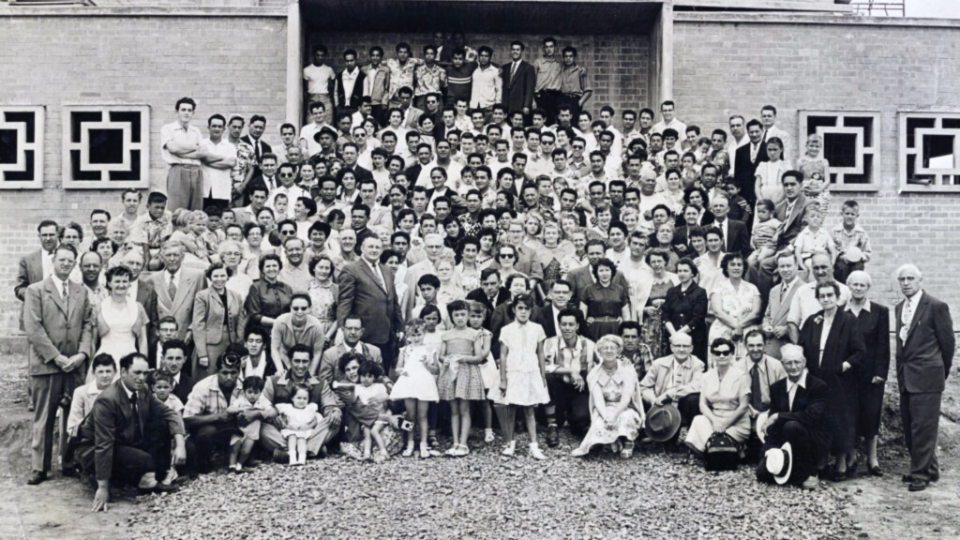
Hamilton-New-Zealand
Labor missionaries at the laying of the cornerstone for the Hamilton New Zealand Temple in December 1956. Elder Hugh B. Brown, who was then an assistant to the Quorum of the Twelve Apostles, presided. Photo courtesy of Church History Library, courtesy of Church News.
A Sacred Place
Despite any discomforts from living on a construction site, Aunty Wai said, “The spirit of the place and the spirit of the people who were called to be missionaries, that made up for anything else.”
President Henry B. Eyring, then first counselor in the First Presidency, noted the special spirit of the place when he traveled to Temple View to dedicate both new and refurbished facilities on the campus of the old Church College, which closed in 2009.
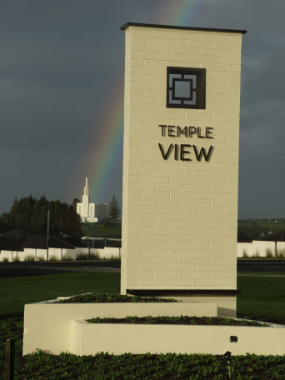
Hamilton-New-Zealand
The Latter-day Saint community of Temple View, New Zealand, is located in the green hills below the Hamilton New Zealand Temple. Photo by Rachel Sterzer Gibson, courtesy of Church News.Copyright 2021 Deseret News Publishing Company.In his remarks during the 2017 dedicatory services, President Eyring recalled his first visit to the area back when he was deputy director of Church education. He climbed a nearby hill until he was almost level with the temple spire and, sitting on his luggage, he painted a watercolor of his beautiful surroundings. “I had a feeling I was looking at sacred ground,” he said.
That sense of sacredness was something that Elder Barry Garlick and his wife, Sister Eva Garlick, noticed as soon as they arrived in Temple View in 2019 to serve as directors of the center and museum.
“There’s a special spirit about that place, and you can’t go there without feeling it,” Elder Garlick said. Where does it come from? “[Temple View] became sacred from the sacrifice and consecration of those who worked and labored there.”
Latter-day Saints who came to serve in many ways consecrated their lives to the Lord and were unified in what they wanted to accomplish, explained Sister Nancy Harward, a Church history specialist serving at the center who researched and wrote much of the key messaging for the exhibit. “In many ways, they built a Zion community.”
This was the Nauvoo experience for the Saints in New Zealand, she added, and quoted the tagline of the exhibit: “The Lord builds a people for the temple.”
The Exhibit
The origins for the new exhibit are rooted in the efforts of Vic and Rangi Parker, who began interviewing and gathering oral histories of labor missionaries in addition to amassing a treasure trove of histories of missionaries who served in New Zealand.
The Church acquired their collection, which is now housed in the Matthew Cowley Pacific Church History Center and Museum.
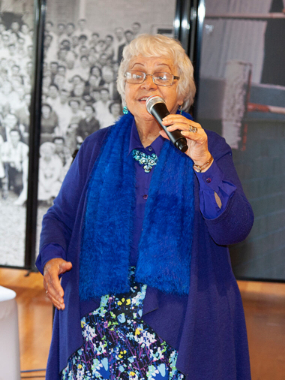
Hamilton-New-Zealand
Rangi Parker sings during the Labor Missionary program. Over the last 40 years, she and her husband, Vic Parker, collected many of the histories, photos and other items used in the creation of the new exhibit “Sacrifice & Consecration: The Lord Builds a People for the Temple” at the Matthew Cowley Pacific Church History Center.Soon after arriving in Temple View to serve as directors of the center and being immersed in the stories of labor missionaries and others who contributed to the building of the school and temple, the Garlicks were asked to give a devotional to a nearby congregation. They felt inspired to share some of the stories they had learned and of the consecration that went into the construction in Temple View. Six young adults approached them afterward and told them, “We have never heard these stories.”
It was like a light turned on, Sister Garlick said. “If this generation hasn’t heard it, then we have to bring this out of the darkness and make sure that it gets shared.”
Vic and Rangi Parker, who serve almost every day at the Church history center, said too few know these stories, which are “inspiring and compelling.”
“We are thrilled they are finally getting shared,” Rangi Parker said.
Vic Parker pointed out that many believe the government built the school. “Many in this generation don’t know the true story of how they sacrificed to build the Church College and the temple.”
The Call
In 1952, during Hui Tau, a national Church conference, New Zealand Mission President Sidney J. Ottley — the father of Gerald Ottley of Tabernacle Choir renown — issued a call to Church members to help in the construction program for a secondary school, the Church College of New Zealand.
The call was not only for laborers, noted Elder Michael Harward, Sister Harward’s husband, who is also a Church history specialist. President Ottley also asked Church members to support the labor missionaries so they could focus solely on construction.
Church members enthusiastically raised their arms to the square, one attendee reported, and Latter-day Saints throughout New Zealand sacrificed food, money, clothes and other resources to sustain the project.
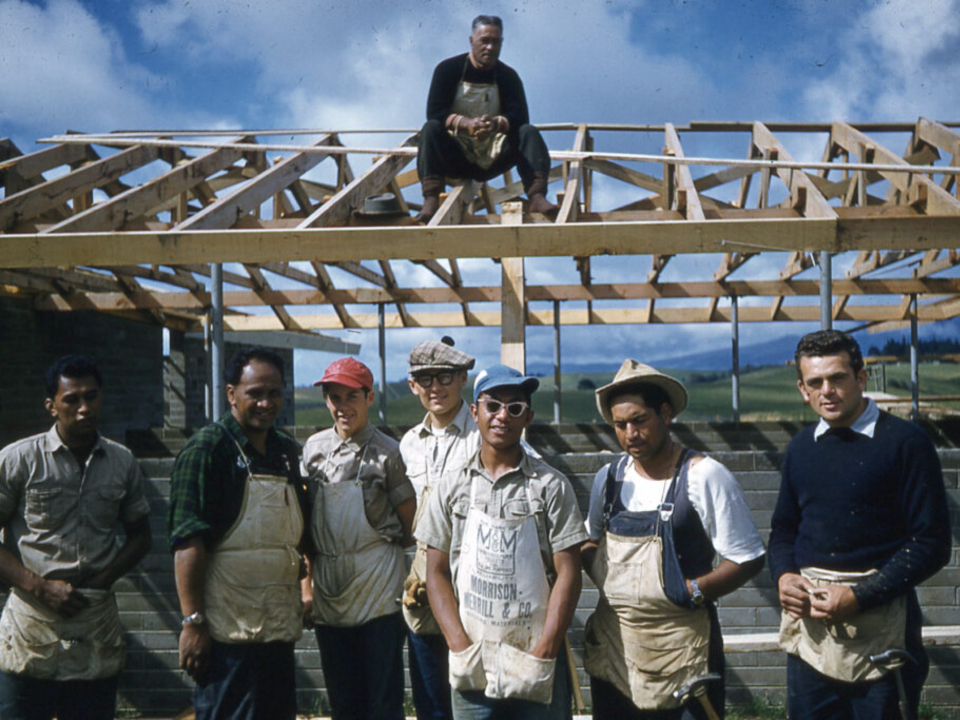
Hamilton-New-Zealand
Labor missionaries in New Zealand circa 1956. Photo courtesy of Church History Library, courtesy of Church News.
Sister Harward explained that while some missionaries were officially called, others simply volunteered or were enlisted by family. Experienced workmen, such as plumbers, electricians, plasterers and engineers, were called from the United States to serve as crew leaders. These supervisors, known as “Zion missionaries,” helped teach Maori volunteers construction skills.
The Saints were overjoyed when, in 1955, President McKay announced the temple would be built on the hill overlooking the college.
“It was a unifying effort for all of the Saints in New Zealand,” Sister Garlick said. “They were all focused on this blessing of the temple.”
“It was the most wonderful thing that ever happened to New Zealand,” Waitohi Elkington said of the labor missionary period. “We have the temple on the hill. It’s still a beacon for the people to come to.”
The Construction Camp
In addition to learning to build physical structures, labor missionaries were also learning to build their faith and leadership skills, Sister Harward explained. Each morning began with group gospel study and prayer for the laborers while the women would hold a similar meeting in the afternoons. Waitohi Elkington recalled gathering together in the evenings to sing hymns.
There was no hierarchy, Elder Harward added. They loved and served and took care of each other. As an example, Elder Harward shared the story of George Cookson, who was from Gisborne on the East Coast of the northern island. Cookson and his wife, Waiwai, lost their first child when she was only 6 days old. The Cooksons lacked the funds to take her back to Gisborne to be buried. After the funeral services, each labor missionary who shook the couple’s hands left money behind so they could return to Gisborne.
Rangi Parker recalled hearing of times when food was scarce in the camp. The group would fast and pray together, and as they closed their fast, they’d hear the trucks pull up with food from across the country. When heavy rains would impede the progress on construction, the camp would fast and pray for Heavenly Father to temper the elements. Miraculously, the clouds would part long enough to finish a task.
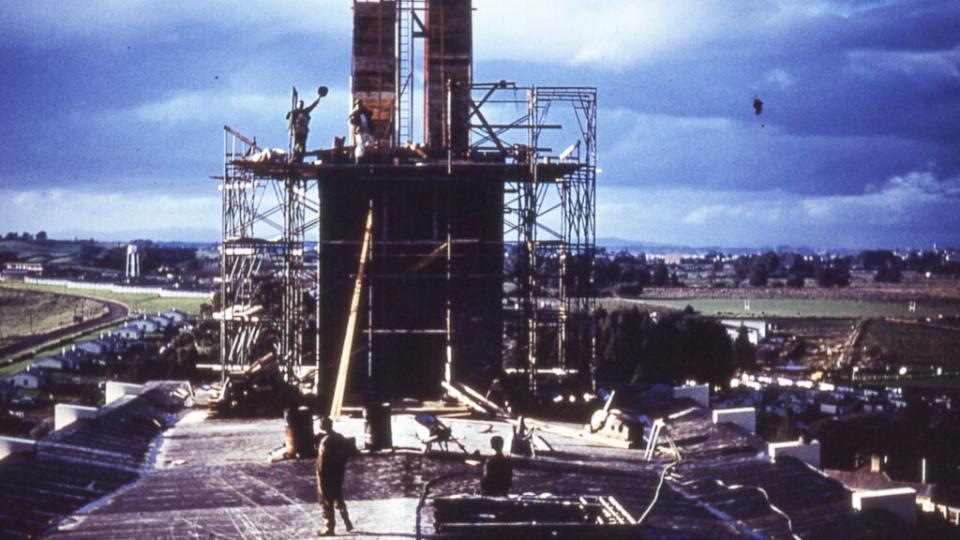
Hamilton-New-Zealand
Photo of the open house for the Hamilton New Zealand Temple, which was dedicated in 1958. Photo courtesy of Church History Library, courtesy of Church News.
“I’ve listened to a lot of their testimonies, and it’s absolutely beautiful and brings tears to your eyes as you’re listening,” Rangi Parker said.
For Waitohi Elkington, life in the construction camp taught her many things, she said. It increased her testimony that the Church was true and grew her desire to be a temple-going person and to be a better mother, wife and neighbor. She also learned that spiritual things are more important than temporal things, she said.
Continued Commitment
Another key message of the exhibit is the continued commitment of members throughout the Pacific to attend the temple.
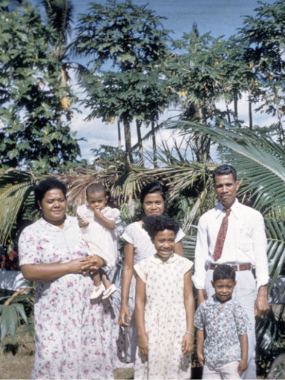
Hamilton-New-Zealand
Vaha’i and Sela Tonga and family in about 1957. They were the first couple to be sealed in the Hamilton New Zealand Temple in 1958. Photo courtesy of Church History Library, courtesy of Church News.Sister Harward shared the story of Loni and Ruby Sikahema — the parents of Elder Vai Sikahema, who was sustained during the April 2021 general conference — who sold the siding off their home to afford the fare from Tonga to New Zealand to attend the temple. Unfortunately, they could only afford a one-way ticket. After they were sealed in the Hamilton temple, Loni Sikahema sheared sheep to earn enough money for the return trip to Tonga.
Vaha’i Tonga and his wife, Sela, Elder Harward said, carefully saved money to attend the temple in New Zealand. However, before the dedication, they were asked to donate money to the building fund for a new chapel for their branch in Tonga. They withdrew their savings from the bank and gave it to the mission president for the chapel. By selling cows, pigs and other items, they earned enough to make the trip to Temple View and were the first couple to be sealed in the Hamilton New Zealand Temple.
The exhibit is about more than just the labor missionaries, Sister Garlick said. “It’s also about the faith of the Saints in the Pacific.”
Legacy for Future Generations
Elder Kazuhiko Yamashita, a member of the Pacific Area Presidency, attended the opening of the exhibition in June. In an email to the Church News, the General Authority Seventy noted the spiritual foundation built by the labor missionary period in New Zealand.
“From the labor missionaries came stalwart Church leaders. They worked hard, they served diligently, they loved each other, they helped each other, they forgot themselves, they served others, they were very patient, they were very obedient, they were willing to sacrifice, and they were one with Christ. … Through their dedicated service, we have been so blessed.”
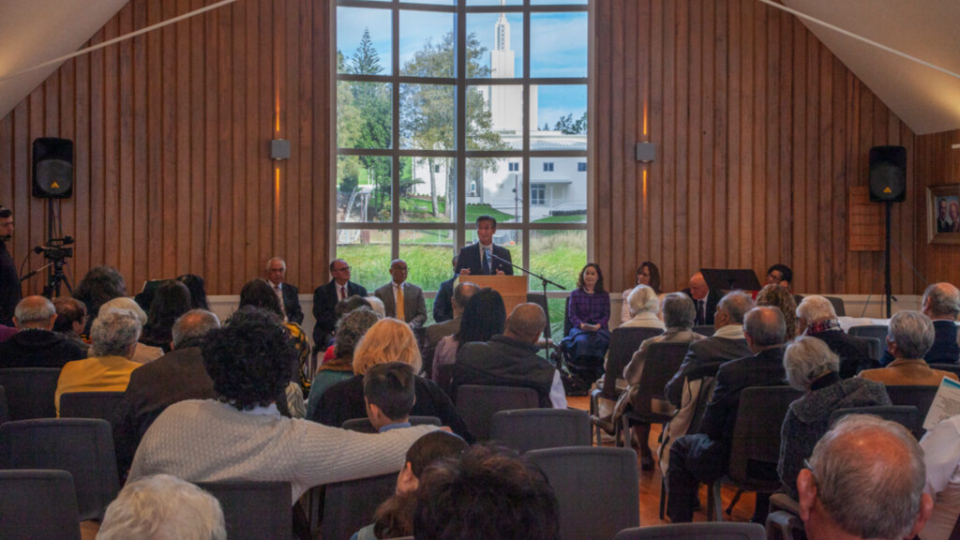
Hamilton-New-Zealand
Elder Kazuhiko Yamashita speaks in the George R. Biesinger Hall adjacent to the Hamilton New Zealand Temple during the opening of a new exhibit on labor missionaries at the Matthew Cowley Church History Center and Museum in Temple View, New Zealand.
Elder Hori Elkington and his wife, Sister Jo-Ena Elkington, who have been serving as directors of the center since January, said they have seen families of the early labor missionaries coming to the exhibit and spending time in the theater, looking at photos and artifacts, reading the stories and watching history unfold. “They’re connecting to their parents, grandparents and great-grandparents,” Elder Elkington said.
Many of the labor missionaries are very humble and were focused on living life rather than recording their experiences. Consequently, Sister Elkington said, many families “have been blown away when they come because they actually have never heard the stories until this exhibition, and now they want to come and hear more.”
Ultimately, that’s exactly what those who worked on the exhibit hope, Sister Garlick said — that the exhibition will serve as a testimony to future generations. “We hope visitors will see how the Lord loves His people in the Pacific.”
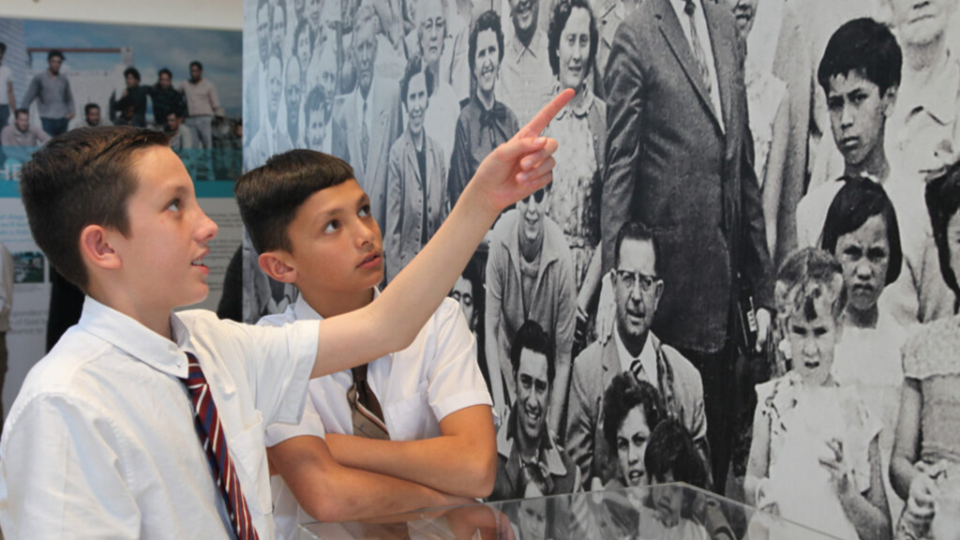
Hamilton-New-Zealand
Eli and Dallin Elkington from the Hamilton area point out their grand-uncle David Elkington, who served as a labor missionary, in a photo at the new exhibit at the Matthew Cowley Pacific Church History Center and Museum in Temple View, New Zealand.
As individuals hear and are inspired by these stories, Sister Harward said, she hopes they will consider: “What am I willing to sacrifice? How well am I consecrating my life to the Lord?”
When Aunty Wai saw the exhibit for the first time, she stood in front of photos of the labor missionaries and was flooded with “good memories.”
“There is a look on the faces of people. You see in their faces how much they love the Church,” she said.
Copyright 2021 Deseret News Publishing Company.